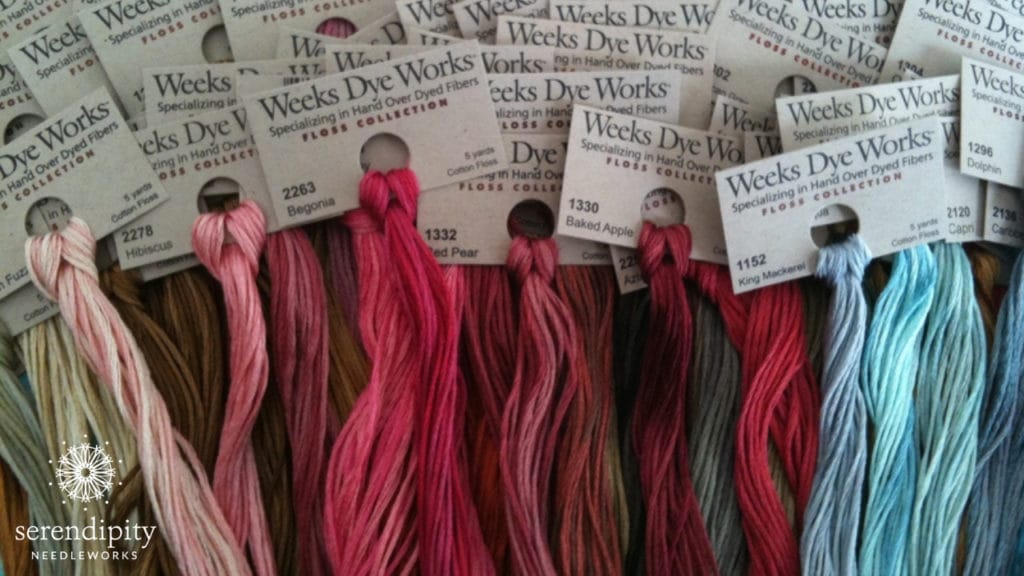Weeks Dye Works six strand floss is a hand over-dyed divisible Egyptian cotton embroidery floss. There are currently 343 exquisite colors available. Most of them are quite subtle, but some of the colors are wildly variegated. Aren’t they gorgeous?
Weeks Dye Works embroidery floss is a staple thread for cross-stitchers, but I adore it for needlepoint!
According to the company’s website, “the colors are variegated enough to be noticeable, yet subtle enough to blend naturally.”
Personally, I tend to gravitate to those subtle hues like the one you see in the picture below…
 And this gorgeous thread is SO easy to use, too! It’s just like working with DMC cotton embroidery floss.
And this gorgeous thread is SO easy to use, too! It’s just like working with DMC cotton embroidery floss.
Just like with any divisible thread, you’ll want to strand (or “strip”) Weeks Dye Works six strand floss before you stitch with it.
Need a refresher on stranding?
Stranding means to separate the strands of a divisible thread, and then put them back together again.
Separate the strands and use as many as you need to get the look you want to achieve. If your goal is full coverage, you’ll want to use 4 strands for 18 mesh canvas and all six strands for 13/14 mesh canvas.
And remember to use a laying tool when working with more than one strand in your needle.
When you’re working with a multicolored thread, like Weeks Dye Works six strand floss…
match up the ends in the same order that you separated them so that the colors line up appropriately.
Cut your pieces approximately 18″ long. Before I cut anything, though, I like to wind the skeins of floss into tiny little balls, just like you’d wind a skein of yarn into a ball for knitting or crocheting.
Here’s another tip for you, too – and it applies to all multicolored threads.
When you prepare to stitch with each subsequent length of thread that you cut, thread your needle on the opposite end of the cut you just made so the color runs remain in sequence. Be careful to avoid leaving long tails when starting or ending a thread, too, since that also affects the color repeat.
And use the continental variation of the tent stitch when working with multicolored threads. If you use the diagonal tent stitch (aka basketweave), you’ll get a weird striping effect.
The range of hues in the Weeks Dye Works six strand floss line of thread is extensive.
Because the threads are hand over-dyed, each skein is a little bit different. It’s always best to purchase all that you think you’ll need for your project from a single dye lot. If you need help in figuring how much thread you’ll need, just grab your free Needlepoint Tips Guide in the banner at the top of this page. 🙂
One of my favorite things about the Weeks Dye Works company is their dedication to our environment.
They are a true “Green Dye House”.
That means all of their dyes are…
- organic and environmentally safe 🌎
- 100% biodegradable and can be discharged directly into the city’s sewer system
- made in America 🇺🇸
- and lead free
AND none of their dyes are listed on California’s Proposition 65, nor are they carcinogenic by IARC, NTP, or OSHA standards.
In addition to all of that, they only use “fast dyes” which means that their threads pass muster as being color fast by industry standards because of their dye selection and a special proprietary process. (I’d still test them, though – especially if you’re going to use the wet blocking method when blocking your finished project.)
Weeks Dye Works six strand floss will work on both 13/14 and 18 mesh needlepoint canvas, but I personally prefer to use it on 18 mesh.
You may use it for stitching all kinds of canvases – from pillows and ornaments to framed designs and stand-ups.
Here are some pictures of stitched samples of Weeks Dye Works cotton embroidery floss worked on 18 mesh canvas…

Alrighty – that’s all for now, my friend. Thank you for dropping by for a visit. Have a terrific rest of your day and, until next time, happy stitching!!
XOXO!!






Excellent!! Great explanation and I picked up a few tricks!!
I’m so glad you enjoyed the blog post, Lynn!! And I’m delighted to know that you got some useful tips you can use on your projects. 😉
XOXO!
Ellen
These are great tips!
Awww… thank you, Terry!! I’m so glad you like them!
XOXO!
Ellen
Thank you for all the wonderful tips!
You’re very welcome, Kappes!! Thank YOU for taking time to drop by for a visit – and for your kind words.
XOXO!
Ellen
Thank you, very informative as we all continue to keep up with the vast array of materials to make a difference in our needlepoint.
Lisha
I’m so glad you found the info helpful, Lisha!
XOXO!
Ellen
I love Weeks’ in floss and No. 5 perle, but I liv3 in Birmingham and have no shops nearby that carry any, much less the full line of colors. Do you have any suggestions? Thanks, just discovered your blog.
Hi Gina
Welcome! It’s so nice to meet you!
There’s a shop in Gulf Shores called Creative NeedleArts and they carry the entire line of Weeks Dye Works floss. They also carry the perle cotton, but I’m not sure they have the full line. It’s definitely worth checking into. 🙂
Have a terrific rest of your day…
XOXO!
Ellen
This was an excellent post and very helpful. I mostly do counted cross stitch and I love Weeks Dye Works flosses and NEVER ever gave a thought to what end I was stitching with or which end to thread the needle etc…!!
I have another question. Weeks flosses are sold in one long continuous five yard piece of six stranded floss. I always cut the floss – I take it off the cardboard name tag, unravel (or unroll it) and then CUT so I have equal length pieces and put it back on the tag and store in a Floss Away baggie. Am I “ruining” the whole purpose of these hand dyed flosses by cutting them into five equal cuts of a yard each first??
Hi Kevin
Thank you for your kind words abut my blog post. I’m so glad you found it helpful. 🙂
You have an excellent question. I think the degree to which the flow of color is interrupted depends upon how much the colors vary within the skein. If you have a monochromatic color, it’s not as noticeable when you pre-cut your pieces. The more wildly varied colors are a different story altogether. I would say that pre-cutting those pieces is riskier. (FYI: This advice actually applies to all hand dyed/over dyed/hand painted threads.)
To prevent any disruption of the flow of color in a skein of multicolored thread, I wrap the thread onto an old wooden sewing thread spool, then cut off whatever length I need for my project. I hope this helps – and if you have any other questions, please ask away. I’m here to help!
Happy stitching…
Ellen